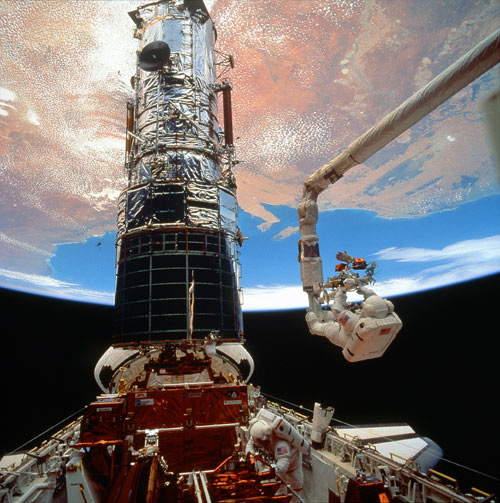
Almost a quarter-century ago, in April 1991, the effort to build today’s International Space Station (ISS) got underway with a pair of spacewalks—one unplanned—outside the shuttle Atlantis. During STS-37, astronauts Jerry Ross and Jay Apt performed the first shuttle-based EVA of the post-Challenger era to manually deploy a balky antenna on the Gamma Ray Observatory (GRO) and to practice techniques and tools for what was then known as Space Station Freedom and which would eventually morph into today’s International Space Station (ISS). As described in the most recent article in this AmericaSpace series on 50 years of EVA accomplishments, it was a quirk of fate that Ross had embarked on the most recent shuttle-based spacewalk and even stranger, perhaps, that he would go on to put this work to exceptional use on the first ISS assembly mission in December 1998.
Notwithstanding rumors of a “secret” EVA, allegedly performed on a classified Department of Defense mission in December 1988—which, if it happened, would also have involved Ross—the first months after the resumption of shuttle flights in the aftermath of the Challenger tragedy were not expected to involve spacewalking. However, all shuttle crews practiced “generic” EVA tasks, related to the manual closure of payload bay doors and latches and tasks associated with their payloads, and throughout 1989 such work occupied Ross and Apt as part of their STS-37 training. Then, in June of that year, NASA initiated the development of the Crew and Equipment Translation Aid (CETA), a kind of hand-pushed “cart”, which would travel along rails to deliver spacewalkers and their tools quickly along Space Station Freedom’s external structure. By the time that CETA was approved, the final payload review for STS-37 had already taken place, but an EVA test was added to the mission manifest in March 1990. Word of an EVA on STS-37 had long preceded the official NASA announcement; certainly, Flight International had noted that formal planning was underway as early as December 1989.
Early plans envisaged CETA as something like an oversized golfing caddy, which NASA engineer Charles “Ed” Whitsett described as “overkill…like taking a bus when all you need to do is go out to the back field on your motorcycle”. At the opposite extreme, astronauts performing a hand-over-hand translation along the station’s exterior was expected to take time and impose unwanted duress on both their space suits and the structure itself, as well as making it difficult to carry large pieces of hardware from place to place. CETA’s beauty was in its simplicity—like a railroad handcar of the Old West—and it would run along a set of rails built into Freedom’s backbone-like truss. For the STS-37 test, Ross and Apt would use a cart on an extendible track in the shuttle’s payload bay, some 46 feet (14 meters) long, and would translate along it in prone positions, hand-over-hand, or angled slightly “upwards”, using pedals. Each technique incorporated brakes and provisions to move in reverse and the task of the spacewalkers was to assess the amount of energy required to perform each movement, as well as comfort, security, control and visibility. The six-hour EVA would also see them performing additional tests by using the Crew Loads Instrument Pallet (CLIP) to measure forces and torques imparted whilst using tools.
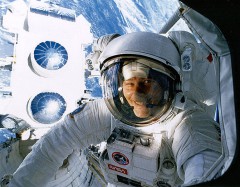
More significantly was a desire on the part of the Astronaut Office to build up a pool of experience, in readiness of an anticipated “wall” of EVAs to build and maintain Freedom from the mid-1990s and beyond. Ross later worked on orbiter-based EVAs, whilst Apt had worked on Freedom-based EVAs, and both men pushed very hard for a series of “standalone” EVAs to build up experience. The paucity of experience in the corps actually convinced Ross, at first, that Steve Nagel would assign Apt and Godwin to perform the EVA. Nagel thought differently. “I understand what you’re saying,” he told Ross, “and I think that’s a good thing to consider, but I’d really look stupid if we had to do some kind of contingency EVA on a primary payload and you weren’t one of the two guys that was outside!”
As described in an earlier AmericaSpace article, the STS-37 EVAs proved highly successful, but by the time the mission ended another ambitious spacewalking flight was already manifested and firmly on the horizon. In May 1992, the maiden voyage of Endeavour (STS-49) got underway and saw not only the first occasion that as many as three and four EVAs were performed during a single shuttle mission, but also the first spaceflight to involve as many as four spacewalkers—Pierre Thuot, Rick Hieb, Kathy Thornton and Tom Akers—and the first (and so far only) three-person EVA to capture the crippled Intelsat 603 communications satellite. Utilizing an ingenious capture bar, together with their own hands and wits, the crew and Mission Control pulled off an incredibly difficult and intricate retrieval effort and restored the shuttle’s EVA credentials as NASA embarked on the road to Space Station Freedom. Intelsat 603 remained operational for more than two decades, before being moved to a “graveyard” orbit early in 2015.
The four STS-49 EVAs totaled 25 hours and 27 minutes, longer than had been accomplished on any prior shuttle mission, and required some sporty additions to the astronauts’ pure-white suits for identification. Thuot (EV1) wore red stripes, Hieb (EV2) had no stripes, Thornton (EV3) had dashed stripes and Akers (EV4) had red diagonal hatches. It was a system which would be followed on several other shuttle missions involving more than two spacewalkers, throughout the 1990s and into the present century, most recently on STS-134, the final flight of Endeavour, in May-June 2011.
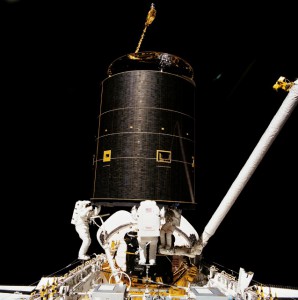
STS-49 demonstrated that more EVA expertise was acutely needed before the construction of Space Station Freedom could begin. “We need better ways to train so that the learning curve isn’t quite so steep,” said the mission’s commander, Dan Brandenstein, whilst Pierre Thuot added that the Intelsat 603 retrieval task was something that the crew “couldn’t train for fully”. As a result, in November 1992, NASA announced that a future shuttle flight, STS-54, would feature an EVA to “fine-tune the methods of training astronauts for assembly tasks in space” and “increase the spacewalk experience levels of astronauts, ground controllers and instructors”. It was noted that more EVA flights would be manifested, but that they would only be attempted if they did not impact primary mission objectives.
For STS-54, which flew in January 1993, it offered a five-hour spacewalk for astronauts Greg Harbaugh and Mario Runco. They moved around the shuttle’s payload bay, with and without “large objects”—including each other—and undertook repeat tasks in the Weightless Environment Training Facility (WETF) at the Johnson Space Center (JSC) in Houston, Texas, after the mission, as part of efforts to enhance future training. In February, NASA announced plans for two more EVAs, on STS-57 and STS-51, several of whose tasks would focus upon the greatest spacewalking challenge of the shuttle era to date: the long-awaited repair and servicing of the Hubble Space Telescope (HST) in December 1993.
On the STS-57 EVA, it was noted that astronauts David Low and Jeff Wisoff would support “procedures using the shuttle’s mechanical arm” planned to “involve work by astronauts on a platform at the end of the shuttle’s arm”, although as circumstances transpired the spacewalkers also played a pivotal role in securing a balky antenna on the just-recovered European Retrievable Carrier (EURECA) satellite. Since STS-57 carried the Spacehab pressurized module in the shuttle’s payload bay, this mission required the astronauts to exit through the connecting tunnel, rather than directly out of the airlock. Less than three months, on STS-51, astronauts Carl Walz and Jim Newman became the first “rookie” U.S. spacewalking duo since the pre-Challenger era and conducted tasks as part of “a continuing commitment by NASA to advance our preparations for future EVA missions, such as the Hubble Space Telescope servicing and Space Station Freedom assembly flights.” In particular, Walz and Newman worked with a power socket wrench, a torque wrench, foot restraints, safety tethers and tool holders.
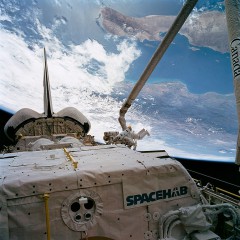
It was clear that the STS-61 Hubble servicing mission would make or break the shuttle’s reputation, particularly in terms of its role in the construction of a future space station. Underwater simulations convinced NASA managers that at least five back-to-back EVAs by four spacewalkers were necessary to “respond to the dynamics, or unknowns, of spacewalks”, and the STS-61 flight plan actually called for a sixth and seventh EVA, although this eventually proved unnecessary. “Doing five [EVAs] really pushed the bounds of what people thought we could do,” STS-61 Commander Dick Covey recalled in a NASA oral history. “Even with four EVA crew members, even with an 11-day mission, it just started pushing the bounds. There was a lot of scrutiny on it and a lot of focus on it.”
All of the STS-61 spacewalkers—Story Musgrave, Jeff Hoffman, Kathy Thornton and Tom Akers—recognized the need to develop physical strength to handle the demands of their space suits and build the necessary stamina for six or seven hours outside. Thornton worked out in the gym, as did the others, although by Hoffman’s admission most of the servicing tasks did not demand immense physical strength, but placed greater emphasis on “technical co-ordination”, involving them “being very careful in how you moved things around and not messing anything up”. Still, with the spectacular servicing and deployment of Hubble in December 1993—which not only featured the record-setting five EVAs, totaling more than 35 hours, by astronauts Story Musgrave, Jeff Hoffman, Kathy Thornton and Tom Akers, but also integrated robotics and maneuvering operations—the shuttle reached a figurative zenith of its achievements, once again proved its capabilities and shed the ghosts of Challenger. A second Hubble servicing mission in February 1997 further upgraded the telescope and readied it for the 21st century.
With the Hubble servicing triumphantly accomplished, further EVA demonstrations characterized the shuttle manifest over the following years. In September 1994, STS-64 astronauts Mark Lee and Carl Meade performed the first “untethered” U.S. spacewalk in a decade, evaluating the Simplified Aid for EVA Rescue (SAFER) jet-propelled backpack, which is today routinely used during ISS-based EVAs. Six months later, during STS-63, astronauts Mike Foale and Bernard Harris—the latter of whom became the first African-American spacewalker—evaluated their suits’ ability to withstand intense heat and cold; work which was extended during an EVA by STS-69 spacewalkers Jim Voss and Mike Gernhardt in September 1995. And four months after that, STS-72 astronauts Leroy Chiao, Dan Barry and Winston Scott supported two EVAs to practice with critical tools for space station assembly, including the body restraint tether, a prototype workstation for the Canadarm2 robotic arm and the Articulating Portable Foot Restraint (APFR).
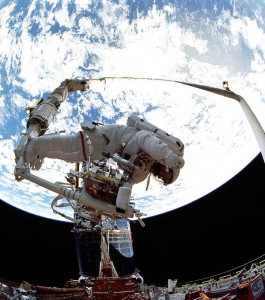
A mere five years had by now elapsed since the EVAs of Jerry Ross and Jay Apt on STS-37 and in early 1996 a program of continuous U.S. presence aboard Russia’s Mir space station got underway. On STS-76, the third shuttle-Mir docking mission, in March, astronauts Linda Godwin and Rich Clifford became the first U.S. citizens to spacewalk outside an Earth-orbiting space station since the Skylab era. Their EVA heralded a series of planned U.S.-Russian spacewalks throughout 1997 and into 1998, several of which proved instrumental in saving Mir from depressurization, following the impact of a Progress resupply ship. In September 1997, Scott Parazynski and Vladimir Titov performed the first shuttle-based EVA to feature a non-U.S. crewman. However, this was not the first U.S.-Russian joint EVA, for astronaut Jerry Linenger had performed a spacewalk outside Mir in April 1997 with his cosmonaut comrade, Vasili Tsibliyev.
In spite of the successes of EVA, the inherent dangers and difficulties were never far away. In November 1996, STS-80 was intended to support two EVAs by astronauts Tammy Jernigan and Tom Jones, but both were canceled when the outer airlock hatch failed to open. “Initially, I thought we just had a sticky hatch and the fact that Tammy’s initial rotation wasn’t able to free it up was just an indication that we’d have to put a little more elbow grease into it,” Jones told a space-to-ground news conference. “Certainly, we are feeling some combination of disappointment at the failure of the hatch, but pleasure in being part of this mission that’s been in every other way very successful,” added Jernigan. The hatch handle apparently stopped after about 30 degrees of rotation, making it unable to release a series of latches around its circumference. An engineering team was promptly assembled to determine the most likely cause of the mishap and Mission Control adjusted the STS-80 crew’s schedule in anticipation of a second attempt on 29 November. A minor problem was also noted with a signal conditioner in Jones’ space suit and it was decided to replace it in the event that the EVA went ahead. Unfortunately, analysis indicated a misalignment of the hatch against the airlock seal and both EVAs were canceled.
A year later, on STS-87, the final shuttle-based EVAs before the assembly of the International Space Station were performed outside Columbia. Astronauts Winston Scott and Takao Doi—the latter of whom became Japan’s first spacewalker—worked on ISS assembly and maintenance tasks, as well as to support the capture of a free-flying solar physics satellite, which had earlier suffered a malfunction during deployment. By the time STS-87 landed, only a year remained before the largest and most complex construction effort in human history was due to get underway. The “Wall of EVA”, which had so worried NASA for so many years, was about to be reached and scaled.
The final part of this series will appear tomorrow.
Want to keep up-to-date with all things space? Be sure to “Like” AmericaSpace on Facebook and follow us on Twitter: @AmericaSpace




Really loving this series of articles, excellent job as always! The Hubble repair missions have to be the most impressive EVAs in my opinion. Just watching a documentary on them had me on the edge of my seat when they stripped out a screw or when they couldn’t get the hatch shut. I am always amazed at the men and women who had the mental and physical strength to complete those missions, they are legendary in my mind, as their contributions have helped scientists on Earth make huge discoveries.